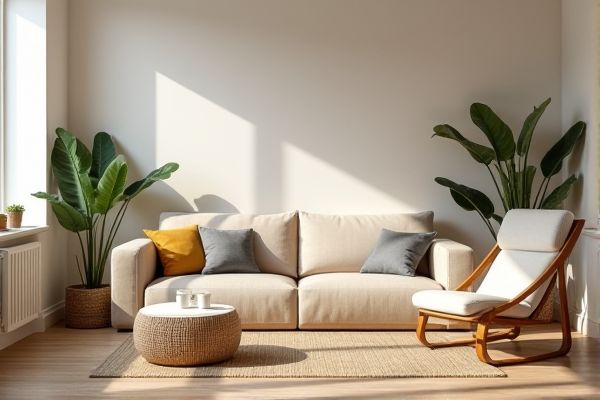
Poly furniture offers superior weather resistance and low maintenance compared to traditional wood furniture, which provides natural beauty and can be refinished over time. Discover which option best suits Your lifestyle and aesthetic preferences by reading the full article.
Table of Comparison
| Feature | Poly Furniture | Wood Furniture |
|---|---|---|
| Material | High-density polyethylene (HDPE) or plastic composites | Solid wood or engineered wood (oak, pine, maple) |
| Durability | Weather-resistant, rot-proof, insect-proof | Strong but susceptible to moisture, pests, and wear |
| Maintenance | Low maintenance; easy to clean with soap and water | Requires regular polishing, sealing, and protection from elements |
| Weight | Lightweight and easy to move | Heavier and less portable |
| Environmental Impact | Often made from recycled plastics; non-biodegradable | Renewable and biodegradable but contributes to deforestation if unsustainably sourced |
| Cost | Generally more affordable and budget-friendly | Higher upfront cost; varies with wood quality |
| Aesthetic | Modern, colorful, and versatile designs | Classic, warm, and natural look |
| Longevity | Lasts 10+ years with minimal wear | Can last decades with proper care |
Introduction to Poly Furniture vs Wood Furniture
Poly furniture offers exceptional durability and weather resistance, making it ideal for outdoor settings, while wood furniture provides natural beauty and classic appeal with customizable finishes. Poly furniture is typically low-maintenance, resistant to fading, cracking, and insects, whereas wood furniture requires regular upkeep to prevent wear and damage. Choosing between poly and wood furniture depends on factors such as climate, aesthetic preference, and maintenance commitment.
Material Composition and Characteristics
Poly furniture is made from high-density polyethylene (HDPE), known for its resistance to moisture, insects, and UV rays, making it highly durable and low-maintenance compared to traditional wood. Wood furniture, composed of natural hardwoods or softwoods, offers a unique grain pattern and natural beauty but requires regular upkeep to prevent damage from weather, pests, and warping. The synthetic nature of poly material provides greater longevity in outdoor settings, while wood offers a classic aesthetic with potential for refinishing and repair.
Durability and Longevity Comparison
Poly furniture, made from high-density polyethylene, offers superior resistance to moisture, insects, and UV damage, ensuring exceptional durability in outdoor environments. Wood furniture, while aesthetically pleasing, requires regular maintenance such as sealing or staining to prevent warping, cracking, and decay caused by weather exposure. Over time, poly furniture tends to maintain structural integrity and appearance longer than wood, making it a low-maintenance, long-lasting option for exterior use.
Weather Resistance and Outdoor Performance
Poly furniture offers superior weather resistance compared to traditional wood furniture, as it is made from high-density polyethylene that resists moisture, UV rays, and temperature fluctuations without warping or rotting. Wood furniture, even when treated, often requires regular maintenance such as sealing or staining to prevent damage from humidity, sun exposure, and pests. For outdoor performance, poly furniture's durability and ease of cleaning make it the preferred choice for withstanding prolonged exposure to harsh weather conditions.
Maintenance and Care Requirements
Poly furniture requires minimal maintenance, needing only occasional cleaning with mild soap and water to prevent dirt buildup and fading. Wood furniture demands more frequent care, including regular polishing, protection from moisture, and treatment to avoid warping or cracking. The durability of poly furniture against weather and pests makes it a low-maintenance alternative suited for outdoor use compared to traditional wood furniture.
Environmental Impact and Sustainability
Poly furniture is often made from recycled plastics, reducing landfill waste and conserving natural resources, which makes it a more sustainable choice compared to traditional wood furniture. Wood furniture production typically involves deforestation, contributing to habitat loss and increased carbon emissions, although responsibly sourced wood certified by organizations like FSC can mitigate these impacts. When selecting furniture, your choice can support environmental sustainability by favoring materials with lower ecological footprints and promoting circular economy principles.
Cost Analysis and Investment Value
Poly furniture generally offers a lower upfront cost compared to wood furniture, making it an attractive option for budget-conscious buyers. Wood furniture, particularly pieces made from hardwoods like oak or maple, tends to hold its value better over time due to its durability and classic appeal. When evaluating investment value, wood furniture often appreciates or maintains worth as a long-term asset, whereas poly furniture may require replacement sooner, affecting overall cost-effectiveness.
Style, Color, and Customization Options
Poly furniture offers a wide range of vibrant color options and modern styles that resist fading and weathering, making it ideal for outdoor use. Wood furniture provides classic, timeless aesthetics with rich, natural grain patterns and can be customized through staining, painting, or carving to suit traditional and rustic tastes. Your choice depends on the desired look, maintenance level, and the flexibility required to personalize your furniture's appearance.
Comfort and Practicality Considerations
Poly furniture offers superior comfort due to its flexibility and ergonomic designs, making it ideal for prolonged use and outdoor settings. Wood furniture provides a sturdy, classic feel but may require cushions for added comfort and demands regular maintenance to prevent wear. Practicality favors poly furniture for its weather resistance and low upkeep, whereas wood furniture offers timeless aesthetics but can be less durable under harsh conditions.
Final Verdict: Which Furniture is Right for You?
Poly furniture offers superior weather resistance, low maintenance, and longevity, ideal for outdoor use or wet climates. Wood furniture provides natural beauty, customizable finishes, and a classic aesthetic, preferred for indoor settings or traditional decor. Choosing between poly and wood furniture depends on your environment, maintenance commitment, and design preference.
 homyna.com
homyna.com